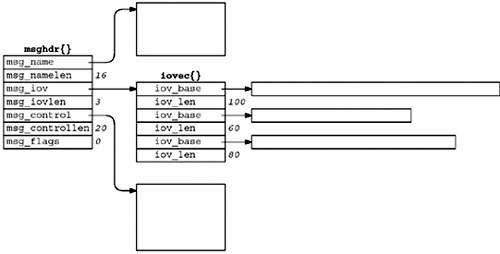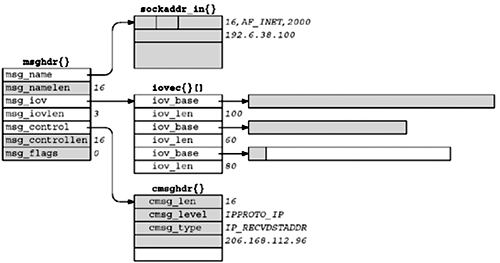14.5 recvmsg and
sendmsg Functions
These two functions are the most general of all
the I/O functions. Indeed, we could replace all calls to
read, readv, recv, and recvfrom
with calls to recvmsg. Similarly all calls to the various
output functions could be replaced with calls to
sendmsg.
|
#include <sys/socket.h>
|
|
ssize_t recvmsg(int sockfd, struct msghdr *msg, int flags);
|
|
ssize_t sendmsg(int sockfd, struct msghdr *msg, int flags);
|
|
Both return: number of bytes read or written if
OK, 鈥? on error
|
Both functions package most arguments into a
msghdr structure.
struct msghdr {
void *msg_name; /* protocol address */
socklen_t msg_namelen; /* size of protocol address */
struct iovec *msg_iov; /* scatter/gather array */
int msg_iovlen; /* # elements in msg_iov */
void *msg_control; /* ancillary data (cmsghdr struct) */
socklen_t msg_controllen; /* length of ancillary data */
int msg_flags; /* flags returned by recvmsg() */
};
The msghdr structure that we show is
the one specified in POSIX. Some systems still use an older
msghdr structure that originated with 4.2BSD. This older
structure does not have the msg_flags member, and the
msg_control and msg_controllen members are named
msg_accrights and msg_accrightslen. The newer
form of the msghdr structure is often available using
conditional compilation flags. The only form of ancillary data
supported by the older structure is the passing of file descriptors
(called access rights).
The msg_name and msg_namelen
members are used when the socket is not connected (e.g., an
unconnected UDP socket). They are similar to the fifth and sixth
arguments to recvfrom and sendto: msg_name points
to a socket address structure in which the caller stores the
destination's protocol address for sendmsg, or in which
recvmsg stores the sender's protocol address. If a
protocol address does not need to be specified (e.g., a TCP socket
or a connected UDP socket), msg_name should be set to a
null pointer. msg_namelen is a value for sendmsg,
but a value-result for recvmsg.
The msg_iov and msg_iovlen
members specify the array of input or output buffers (the array of
iovec structures), similar to the second and third
arguments for readv or writev. The
msg_control and msg_controllen members specify
the location and size of the optional ancillary data.
msg_controllen is a value-result argument for
recvmsg. We will describe ancillary data in Section
14.6.
With recvmsg and sendmsg, we
must distinguish between two flag variables: the flags argument, which is passed by value, and
the msg_flags member of the msghdr structure,
which is passed by reference (since the address of the structure is
passed to the function).
-
The msg_flags member is used only by
recvmsg. When recvmsg is called, the flags argument is copied into the
msg_flags member (p. 502 of TCPv2) and this value is used
by the kernel to drive its receive processing. This value is then
updated based on the result of recvmsg.
-
The msg_flags member is ignored by
sendmsg because this function uses the flags argument to drive its output processing.
This means if we want to set the MSG_DONTWAIT flag in a
call to sendmsg, we set the flags argument to this value; setting the
msg_flags member to this value has no effect.
Figure
14.7 summarizes the flags that are examined by the kernel for
both the input and output functions, as well as the
msg_flags that might be returned by recvmsg.
There is no column for sendmsg msg_flags because, as we
mentioned, it is not used.

The first four flags are only examined and never
returned; the next two are both examined and returned; and the last
four are only returned. The following comments apply to the six
flags returned by recvmsg:
|
MSG_BCAST
|
This flag is relatively new, supported by at
least BSD, and is returned if the datagram was received as a
link-layer broadcast or with a destination IP address that is a
broadcast address. This flag is a better way of determining if a
UDP datagram was sent to a broadcast address, compared to the
IP_RECVDSTADDR socket option.
|
|
MSG_MCAST
|
This flag is also a fairly recent addition,
supported by at least BSD, and is returned if the datagram was
received as a link-layer multicast.
|
|
MSG_TRUNC
|
This flag is returned if the datagram was
truncated; in other words, the kernel has more data to return than
the process has allocated room for (the sum of all the
iov_len members). We will discuss this more in Section
22.3.
|
|
MSG_CTRUNC
|
This flag is returned if the ancillary data was
truncated; in other words, the kernel has more ancillary data to
return than the process has allocated room for
(msg_controllen).
|
|
MSG_EOR
|
This flag is cleared if the returned data does
not end a logical record; the flag is turned on if the returned
data ends a logical record. TCP does not use this flag since it is a byte-stream
protocol.
|
|
MSG_OOB
|
This flag is never returned for TCP out-of-band data. This
flag is returned by other protocol suites (e.g., the OSI
protocols).
|
|
MSG_NOTIFICATON
|
This flag is returned for SCTP receivers to
indicate that the message read is an event notification, not a data
message.
|
Implementations might return some of the input
flags in the msg_flags
member, so we should examine only those flag values we are
interested in (e.g., the last six in Figure 14.7).
Figure
14.8 shows a msghdr structure and the various
information it points to. We assume in this figure that the process
is about to call recvmsg for a UDP socket.

Sixteen bytes are allocated for the protocol
address and 20 bytes are allocated for the ancillary data. An array
of three iovec structures is initialized: The first
specifies a 100-byte buffer, the second a 60-byte buffer, and the
third an 80-byte buffer. We also assume that the
IP_RECVDSTADDR socket option has been set for the socket,
to receive the destination IP address from the UDP datagram.
We next assume that a 170-byte UDP datagram
arrives from 192.6.38.100, port 2000, destined for our UDP socket
with a destination IP address of 206.168.112.96. Figure 14.9 shows all the information in the
msghdr structure when recvmsg returns.

The shaded fields are modified by
recvmsg. The following items have changed from Figure 14.8 to Figure 14.9:
-
The buffer pointed to by msg_name has
been filled in as an Internet socket address structure, containing
the source IP address and source UDP port from the received
datagram.
-
msg_namelen, a value-result argument,
is updated with the amount of data stored in msg_name.
Nothing changes since its value before the call was 16 and its
value when recvmsg returns is also 16.
-
The first 100 bytes of data are stored in the
first buffer; the next 60 bytes are stored in the second buffer;
and the final 10 bytes are stored in the third buffer. The last 70
bytes of the final buffer are not modified. The return value of the
recvmsg function is the size of the datagram, 170.
-
The buffer pointed to by msg_control is
filled in as a cmsghdr structure. (We will say more about
ancillary data in Section 14.6 and
more about this particular socket option in Section 22.2.)
The cmsg_len is 16; cmsg_level is
IPPROTO_IP; cmsg_type is IP_RECVDSTADDR;
and the next 4 bytes contain the destination IP address from the
received UDP datagram. The final 4 bytes of the 20-byte buffer we
supplied to hold the ancillary data are not modified.
-
The msg_controllen member is updated
with the actual amount of ancillary data that was stored. It is
also a value-result argument and its result on return is 16.
-
The msg_flags member is updated by
recvmsg, but there are no flags to return to the
process.
Figure
14.10 summarizes the differences among the five groups of I/O
functions we described.

|